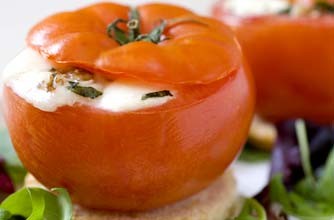The current dismal state of the economy is horribly depressing, stagnant, and no one has any clue when things will turn around. Our wallets are thin, and the grocery store checkout lane almost bring tears to our eyes. Who better to turn to than professional chefs for money saving cooking and shopping tips? We put a shout out on Twitter, several chef forums, as well as scoured the recent news, and here are our results!
 Break it down yourself. Our local Telluride friend Chef Bud Thomas hosts a live internet cooking show and and has a blog with gorgeously simple recipes. Bud recommends buying an entire bird, not only can you save over $13, but you can use the bones for stock.
Break it down yourself. Our local Telluride friend Chef Bud Thomas hosts a live internet cooking show and and has a blog with gorgeously simple recipes. Bud recommends buying an entire bird, not only can you save over $13, but you can use the bones for stock.
Here is his chicken price breakdown, whole versus pieces: “:Whole $7.72. Pieces: two breasts $11.31, two thighs $2.47, two drumsticks $3.44, two wings $4.72. Total cost whole bird = $7.72 Total cost pieces = $20.79. Price difference = $13.07” Eye opening isn’t it?
Sacramento personal Chef Jeff McDonald shares his grocery shopping essentials here, and we love his tip for block cheese: “Shred cheese yourself to save money. Pre shredded cheeses are convenient, but if you’re willing to shred as you go, you’ll get twice the cheese for your money.” We all know this but do we really practice it? Next time you’re about to grab the bag of cheese, stop! Not only will your wallet thank you but your taste buds will as well.
Use every part of the animal possible, a tip Julia Child would surely endorse! Hector Santiago is the chef and owner of the Atlanta tapas restaurant Pura Vida. He tells the Restaurant Informer his means of coping. “The way I work is, I cut my costs by making sure I am using everything, every possible part of my ingredients. I get, say, a whole trout; I don’t throw anything away but the guts. If it comes with roe, we use the roe for caviar. The bones we make into stock. We get the most out of the product by making sure nothing goes to waste.”
Grow your own. Season 4 Top chef Mark Simmons from Get Fresh in Brooklyn grows a small garden in his restaurant patio. He offers organic gardening tips here, and recommends stretching your dollar by growing swiss chard, spinach, and kale, as they produce leaves for the entire growing season. Tomatoes and peppers are also recommended, as the canned sauces can be used year round.
 Fish Tips: Our friend, Chef and author Ben Diaz (featured left) sent us the following tip: “When buying fish always try to buy it whole. It’s a little more work but your fish will stay fresher for up to 3 more days. Always check availability, buying fish when they are in season is a great way to save money and ensuring that you get the highest quality possible.” Thank you Ben!
Fish Tips: Our friend, Chef and author Ben Diaz (featured left) sent us the following tip: “When buying fish always try to buy it whole. It’s a little more work but your fish will stay fresher for up to 3 more days. Always check availability, buying fish when they are in season is a great way to save money and ensuring that you get the highest quality possible.” Thank you Ben!
In an interview with NPR, Naked Chef Jamie Oliver says that “Seafood can be expensive. There’s people’s time and labor and petrol costs to get the boats out there. Talk to your fishmonger (or local fish market) and tell him you’re on a budget and set him the task of sorting you out. Fishmongers and butchers have had a lot of business taken away from them by supermarkets. If you just talk to your butcher or fishmonger and say, I’ve only got three dollars, I’ve got two kids, what can I do? I think you’d genuinely be surprised with what you come back with.”
Shop around. Stores such as Whole Foods are so fun to shop in but can really siphon your dollars if you aren’t careful. The Washington Post reports that DC area restaurant chefs have been saving money shopping in Asian superstores such as H Mart, for their affordable and exotic ingredients including noodles, fresh seafood, and produce. If you are lucky enough to have such ethnic markets in your area, go exploring!
Shop local. North Carolina chef Amy Tornquist of Watts Grocery restaurant saves money while remaining committed to regional sustainable food. She tells Southern Living magazine “if it’s a decision between buying organic at the grocery store or fresh from your local farmers’ market, always go with local first,” and believes that small farmers primarily use organic growing methods, but may not have the size or money to be certified as organic. Her farmers market tips include: getting there early for the best selection, and to build relationships with the farmers, not only to learn more about them, but they can often give you recipe ideas and tips on how to best use their produce.
Make a list. Oprah recently had a show where celebrity chefs moved into viewers homes to help them save money. Cat Cora‘s tip is so basic but essential, always have a plan and bring a shopping list to the store, “the statistic is literally that people spend 50 percent more than they need to if they don’t have a list”. Guilty, guilty we are with this one, thinking, “the list is in my head!”. Our new mission is to never leave home without one.
Make your own. Chef Curtis Stone was also on the show and was a fan of making your own snacks. He suggests buying tortillas in packs (flour or corn) and making homemade chips as cheaper, healthier alternative to bagged chips.
 Make homemade spices! Our friend Chef Ray Duey (the chef shown on the right) from Chef Garnish sent us a great tip via email. “When I juice vegetables I save the extracted pulp and dehydrate it. I then grind it and add a little sea salt and fresh ground pepper and viola, homemade, non wasted, fresh made Mrs. Dash seasoning !!” We love this one!
Make homemade spices! Our friend Chef Ray Duey (the chef shown on the right) from Chef Garnish sent us a great tip via email. “When I juice vegetables I save the extracted pulp and dehydrate it. I then grind it and add a little sea salt and fresh ground pepper and viola, homemade, non wasted, fresh made Mrs. Dash seasoning !!” We love this one!
Stop wasting. Award winning NYC Personal Chef Mark Tafoya is one of our first chef friends we met on Twitter. Our favorite tip of his includes not wasting your broccoli stalks, remove the rough outside with a vegetable peeler and use the rest! You can listen to it here. He also has a free podcast packed with delicious recipes and tips.
Save with slow food. Chef Ming Tsai is a fan of crockpot cooking to balance your budget, and shares his favorite slow cooker recipes with the ABC show The View, including a delicious Asian Beef Stroganoff .
So there you have it! Perhaps basic, common sense tips really, but a nice reminder and reality check for us all. Do you have any favorite tips money saving tips to share? Do tell in the comments please!




